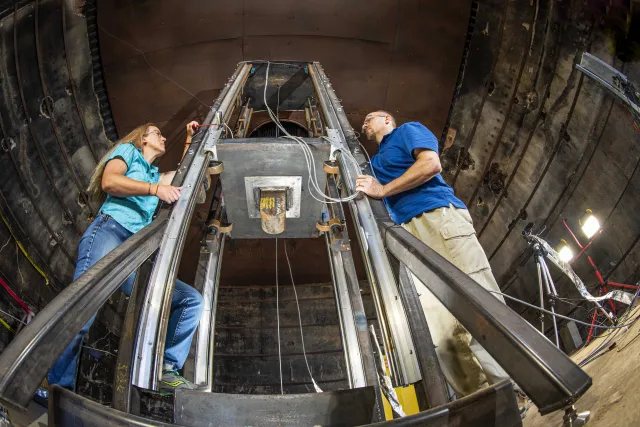Sandia Labs increases efforts at abusing lithium-ion batteries for safety research
Aug 13, 2019 08:48 PM ET

According to a press release from Sandia National Laboratories, the testing lab now uses an indoor tower to drop 200-lb+ weights on lithium-ion batteries in efforts to learn more about how batteries respond to stress. This will be especially helpful in understanding how electric vehicle batteries may respond in an automobile accident.
“This becomes our ninth way of killing a battery,” said Sandia battery-abuse testing engineer Chris Grosso. “It hits with so much force that so far we are just chopping the batteries in half.”
The constant push for more storage and power drives the need for tests such as those offered by the new drop tower, said Sandia mechanical engineer June Stanley.
“As far as we know nobody in the U.S. has done any drop tests for impact testing like this,” Stanley said. The data collected will aid in developing safer, more reliable batteries with more efficient performance. It will also help in responding to emergencies, such as electric-vehicle crashes, she said.
“An impact test like this is more real world, more realistic to what would happen,” she said. “The test can give us a better understanding for first responders and how they handle an emergency. It can also be beneficial for industry researching and developing new technology.”
The drop tower is inside a 14-ft tall hangar-type building that can easily be vented and cleared if there’s smoke from a battery fire. Researchers control the tower remotely and watch the action on monitors inside a trailer parked about 30 yd away.
A battery sits in a steel tray bolted to a load cell to measure the impact force at the base of the tower as a weight of at least 200 lb is perched above at heights up to 8 ft, 8 in. The push of a button unleashes the weight, and gravity takes over. Wires connected to the battery and the tower measure speed, force, temperature and voltage. Cameras record the impact and resulting carnage. Data flashes to computers in the trailer.
So far, the team has tested single-cell lithium-ion batteries and a 12-pack of such batteries taped together. While, the tests have not produced the sparks and heat that would occur in a slower-moving hydraulic crush test, they have collected useful data, Stanley said.
In the aftermath of the drop, the batteries are unstable and the safety status of about half the cells is unknown, she said. “It certainly helps with a better understanding for first responders to handle a situation like that.”
The maximum weight that can be used to smash, crush or chop a battery is 500 lb because of the components chosen, Grosso said. “That can easily be upgraded, if needed, and we can keep adding weight to get more force.”
Also read
- Ingeteam to Power Gentari’s Pioneering NSW Solar-Storage Hybrid by 2027
- Minnesota Approves 475 MW Solar, Storage Projects Expansion
- Green Genius Secures €36.7M for Major Lithuanian Solar Project
- Copenhagen Energy Taps Energrid to Build 132 MWh Danish Batteries
- UbiQD Secures Landmark Quantum Dot Deal with First Solar
